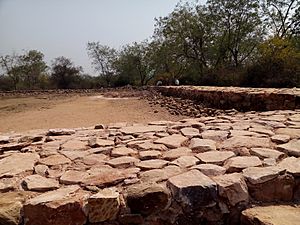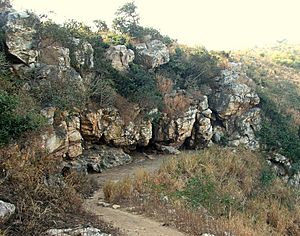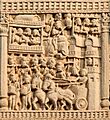Ajatashatru facts for kids
Quick facts for kids Ajatashatru |
|
|---|---|

Royal procession leaving Rajagriha, possibly depicting Ajatashatru, from Sanchi
|
|
| 2nd Haryanka Emperor | |
| Reign | c. 492 – c. 460 BCE or early 4th cent. BCE |
| Predecessor | Bimbisara |
| Successor | Udayabhadra |
| Governor of Champa | |
| Reign | ? – c.492 BCE |
| Died | 460 BCE or c. 380 BCE |
| Spouse |
|
| Issue | Udayabhadra |
| Dynasty | Haryanka |
| Father | Bimbisara |
| Mother | Queen Chellana (Sanskrit: Cellaṇā), daughter of President Chetaka (Jainism) Queen Kosala Devī (Buddhism) |
| Religion | Jainism Buddhism |
Ajatashatru was a powerful king of the Haryanka dynasty in ancient Magadha, a kingdom in East India. He lived around 492 to 460 BCE. His name means "one who has no enemies." He was the son of King Bimbisara. Ajatashatru lived at the same time as important religious leaders like Mahavira (founder of Jainism) and Gautama Buddha (founder of Buddhism).
Ajatashatru took control of the Magadha kingdom from his father. He was known for his strong desire to expand his kingdom. He fought and won wars against neighboring states, including the Vajjika League led by the Licchavis. He conquered the republic of Vaishali. He also helped build the city of Pataliputra by fortifying a village. Under Ajatashatru, Magadha became the strongest kingdom in North India. He is also thought to have invented two special war weapons: the rathamusala (a chariot with blades) and the mahashilakantaka (a large stone-throwing machine, like a catapult).
Contents
When Did Ajatashatru Rule?
Historians believe Ajatashatru became king around 491 BCE. This timing is based on old texts like the Mahavamsa. His first military campaigns might have happened around 485 BCE. His wars against the Vajjis likely took place around 481–480 BCE.
Ajatashatru's Early Life

Ajatashatru was also known by the name Kunika. He was the son of King Bimbisara. Stories about Ajatashatru's birth are found in both Buddhist and Jain religious writings.
In Jainism, his mother was Queen Chellana. In Buddhism, his mother was Queen Kosala Devi. Interestingly, both queens were sometimes called "Vaidehi" in these ancient stories.
Wars and Conquests
Ajatashatru was a very ambitious king. He wanted to make his kingdom, Magadha, bigger and more powerful. He fought many wars to achieve this goal.
Conquering Vaishali
One of Ajatashatru's most famous conflicts was the war against the Licchavis of Vaishali. This war lasted for many years, from about 484 to 468 BCE.
Jain Stories of the War
According to Jain stories, the war started over a valuable elephant and a special necklace. These items belonged to Ajatashatru's half-brothers, Halla and Vihalla. When Ajatashatru's wife, Queen Padmavati, wanted these items, Ajatashatru demanded them. His brothers refused, saying their father had given them these gifts.
Halla and Vihalla then fled to their grandfather, Chetaka, who was the king of Vaishali. Ajatashatru asked Chetaka to hand them over, but Chetaka refused. This led to a huge war. Ajatashatru gathered a massive army. Chetaka also called upon his allies, including 9 Mallas, 9 Lichhvis, and 18 kings from Kasi-Kosala. Both sides had enormous armies with thousands of elephants, chariots, horses, and foot soldiers.
During the war, Chetaka, a follower of Mahavira, had a vow to shoot only one arrow per day. His arrows were always accurate and deadly. He killed ten of Ajatashatru's commanders. As Ajatashatru faced defeat, he prayed for help. According to the story, gods helped him. They made pebbles and leaves thrown by Ajatashatru's soldiers feel like rocks to the enemy. This weapon was called Mahasilakantaka. The gods also gave Ajatashatru a special war chariot called Ratha-Musala. This chariot had swinging spiked clubs and crushed many soldiers.
Despite these new weapons, Chetaka and his allies retreated into the strong city walls of Vaishali. Ajatashatru could not break through. He then used a trick. He sent a spy, disguised as an astrologer, into Vaishali. The spy convinced the people to remove a sacred altar, saying it was causing bad luck. Once the altar was removed, the city's protection was weakened. Ajatashatru then launched a final attack and conquered Vaishali.
Buddhist Stories of the War
Buddhist stories also describe the war with the Vajjis (Licchavis). They say the conflict began over a diamond mine near the Ganges river. Ajatashatru and the Licchavis had agreed to share the diamonds equally. However, the Licchavis took most of them, making Ajatashatru angry.
He wanted to destroy the powerful Vajjis. He sent his chief minister, Vassakara, to the Buddha to ask why Vaishali was so strong. The Buddha gave seven reasons, including their discipline, respect for elders and women, and their sacred altars (Chaityas).
With Vassakara's help, Ajatashatru managed to cause disagreements among the Vajjis. He also destroyed the altars inside the town. During this battle, Ajatashatru used his scythed chariot, which had blades and a swinging mace. He attacked the town and conquered it.
Ajatashatru's Kingdom
After his father's death, Ajatashatru moved his capital from Rajgriha to Champa. This was part of his efforts to strengthen and expand his kingdom.
Ajatashatru's Family
Jain Accounts of His Family
In Jain texts like the Nirayāvaliyā Suttā, Ajatashatru's mother was Queen Kosala Devi. She was the daughter of Chetaka, the king of Vaishali. Chetaka was also the brother of Queen Triśalá, who was the mother of Mahavira. Ajatashatru is said to have had eight wives.
Buddhist Accounts of His Family
Buddhist texts, such as the Dīgha nikāya, state that Ajatashatru's mother was Queen Kosala Devi. She was the daughter of Maha-Kosala, the king of Kosala. She was also the sister of Pasenadi, who later became king. Ajatashatru had many wives, but his main wife was Princess Vajira.
The city of Kasi was given to Bimbisara as a wedding gift. After Ajatashatru took over, King Prasenajit of Kosala took Kasi back. This led to a war between Ajatashatru and Prasenajit. The war ended with a peace treaty, and Prasenajit married his daughter Vajira to Ajatashatru. Later, Ajatashatru had a son named Udayabhadda or Udayabhadra.
How Ajatashatru Died
Historians believe Ajatashatru died around 461 BCE or 460 BCE. The stories about his death are different in Jain and Buddhist traditions.
Jain Stories of His Death
According to Jain texts, Ajatashatru wanted to become a "Chakravartin," a world-monarch. He tried to conquer the world, but a guardian god stopped him. The god told him that only 12 Chakravartins could exist in a certain time period, and all 12 had already appeared. Ajatashatru became arrogant and threatened the god. The god, angered by his pride, turned him to ashes on the spot. Jain beliefs state that Ajatashatru was then reborn in a lower realm.
Buddhist Stories of His Death
In Buddhist tradition, Ajatashatru's own son, Udayabhadra, took over the kingdom. Buddhist texts say Ajatashatru was reborn in a difficult realm because of his past actions.
Even though the stories of his death are different, both Jain and Buddhist traditions believe that after many rebirths, Ajatashatru will eventually be reborn as a wise prince, become a monk, and achieve spiritual freedom.
Ajatashatru's Religious Beliefs
Ajatashatru is mentioned in both Jain and Buddhist religious writings.
Jainism
The Jain text Uvavai Sutta shows that Ajatashatru respected Mahavira greatly. It even says he had an officer whose job was to report on Mahavira's daily activities. This text describes Mahavira's visit to the city of Champa and the honor Ajatashatru showed him.
Buddhism
In Buddhist tradition, the Samaññaphala Sutta describes Ajatashatru's first meeting with the Buddha. During this meeting, Ajatashatru realized some of his past mistakes. He then took refuge in the Buddha, the Dhamma (teachings), and the Sangha (community). He is mentioned in other Buddhist texts as a strong follower of the Buddha. Ajatashatru also built a large Stupa (a dome-shaped structure) over the Buddha's remains after his funeral. He was also present at the first Buddhist council, a meeting of Buddhist monks, held in the Sattapanni caves in Rajgriha.
In some later Buddhist traditions, Ajatashatru is seen as an example of an ordinary person who can be saved by the Buddha's kindness, even after making many mistakes.
Both Jain and Buddhist texts show Ajatashatru as a devoted follower of their respective religions.
Images for kids
-
Royal procession leaving Rajagriha, possibly depicting Ajatashatru, from Sanchi
-
Ajatashatru worships the Buddha, relief from the Bharhut Stupa at the Indian Museum, Kolkata
See also
 In Spanish: Áyata Shatru para niños
In Spanish: Áyata Shatru para niños











